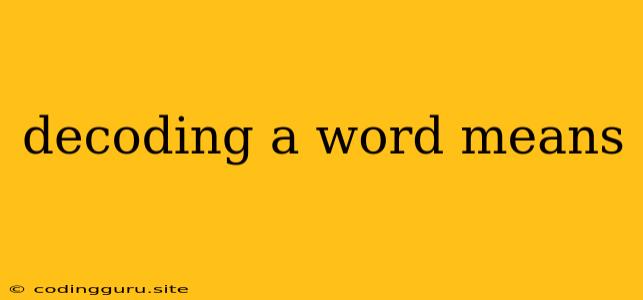Decoding a Word: Unveiling the Meaning Behind the Letters
Have you ever come across a word that seemed utterly foreign, its letters forming an impenetrable barrier to understanding? The act of decoding a word goes beyond simply recognizing individual letters; it delves into the intricate world of language, unraveling the meaning hidden within its structure. This process, often referred to as "word recognition," is a fundamental skill in reading comprehension and communication.
But what exactly does it mean to decode a word?
Decoding is essentially breaking down a word into its component parts, identifying the sounds associated with those parts, and then blending those sounds together to form the word's pronunciation. This process can be likened to putting together a puzzle, where each letter represents a piece, and the final picture represents the word's meaning.
Here are some strategies to decode a word effectively:
- Phonics: This is the foundation of decoding, focusing on the relationship between letters and their corresponding sounds. By understanding the sounds associated with individual letters and letter combinations (like "sh" or "th"), you can begin to break down words phonetically.
- Syllabication: Dividing a word into its syllables can make it easier to pronounce. Identifying the syllable boundaries helps isolate the individual sounds within the word, making it easier to decipher.
- Contextual Clues: The surrounding words and sentences can provide valuable hints about the meaning of an unfamiliar word. Look for clues like synonyms, antonyms, or examples that can shed light on the word's definition.
- Visual Clues: Sometimes, the structure of a word can provide clues. Look for familiar prefixes (like "un-", "re-", "pre-") or suffixes (like "-ing", "-ed", "-ly") that can indicate the word's part of speech or its general meaning.
- Word Families: Recognizing patterns within word families can help decode unfamiliar words. For example, knowing the word "cat" can make it easier to understand words like "hat," "mat," and "sat."
Let's illustrate with an example:
Suppose you encounter the word "unbelievable". To decode it, you can break it down into its parts:
- "un" - This prefix often means "not".
- "believable" - This part of the word suggests something that can be believed.
By combining these parts, you can infer that "unbelievable" means "not believable" or "impossible to believe."
Why is decoding a word so crucial?
- Reading Comprehension: Understanding the meaning of words is essential for comprehending written text. Decoding allows you to access the information conveyed by the text, enabling you to understand the author's message.
- Vocabulary Expansion: As you decode more and more words, your vocabulary expands. This allows you to express yourself more effectively in both written and spoken language.
- Academic Success: Strong decoding skills are critical for academic achievement. They enable students to understand complex texts, participate in classroom discussions, and perform well on assessments.
In conclusion, decoding a word is a fundamental process in language acquisition and comprehension. By understanding the strategies and applying them effectively, you can unlock the meaning of words and navigate the world of language with greater confidence and fluency.
